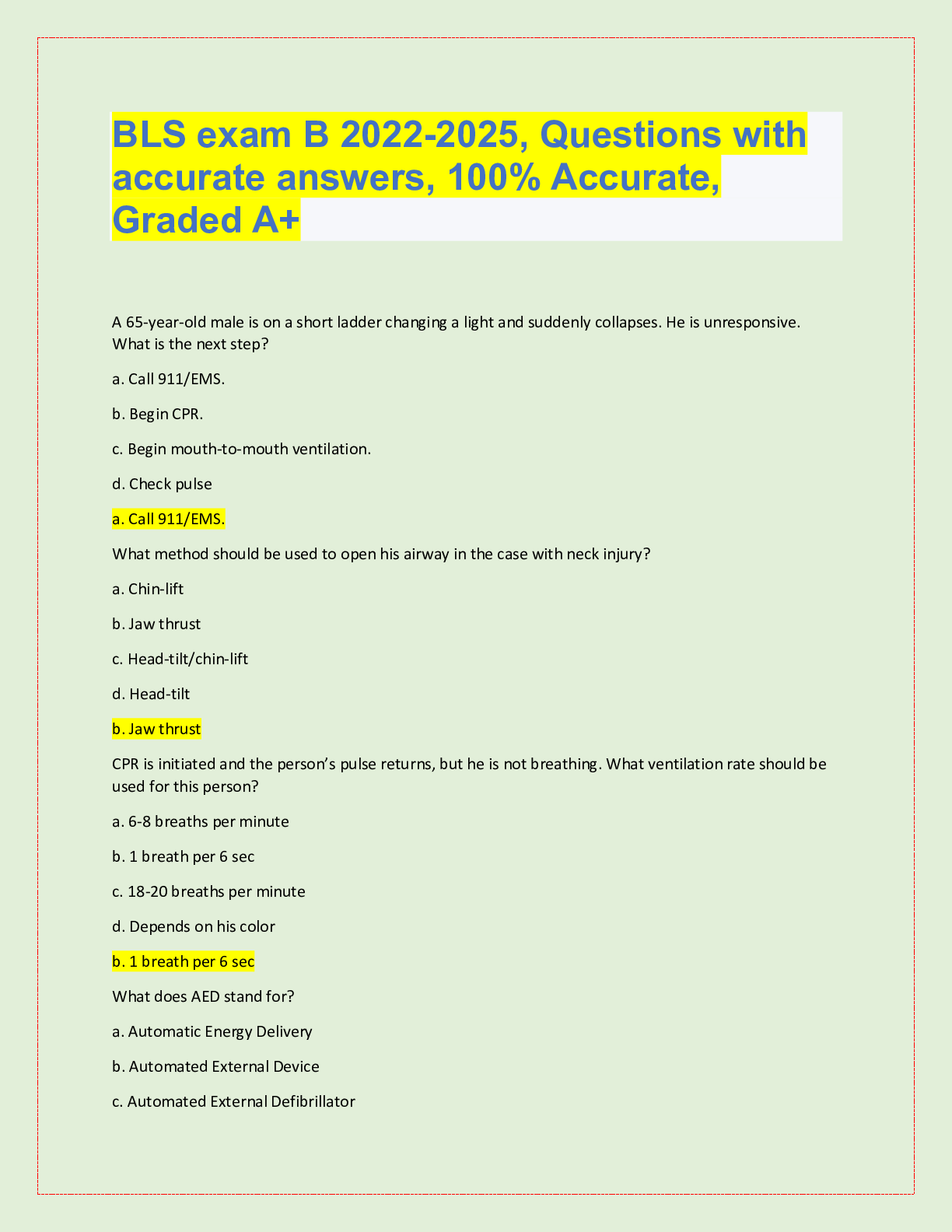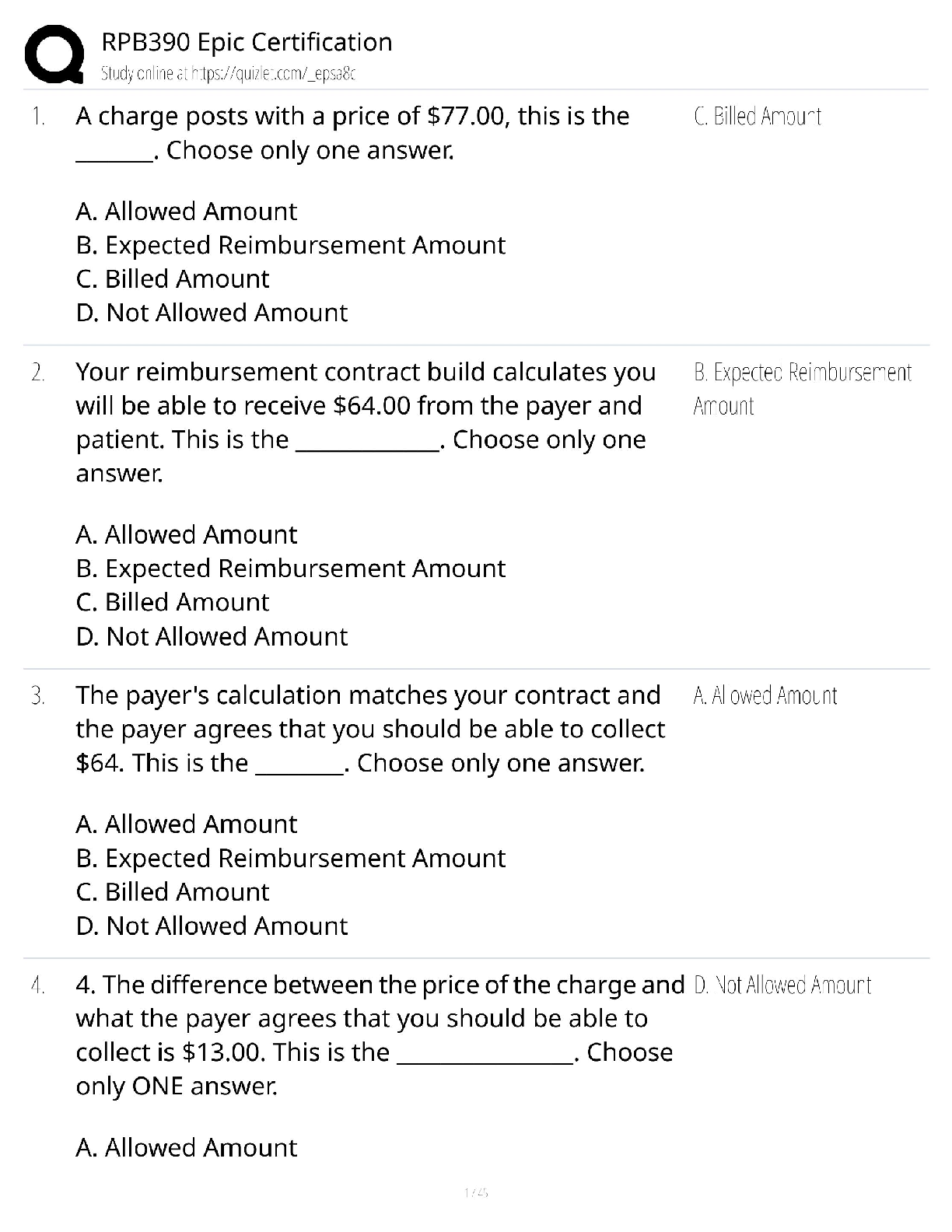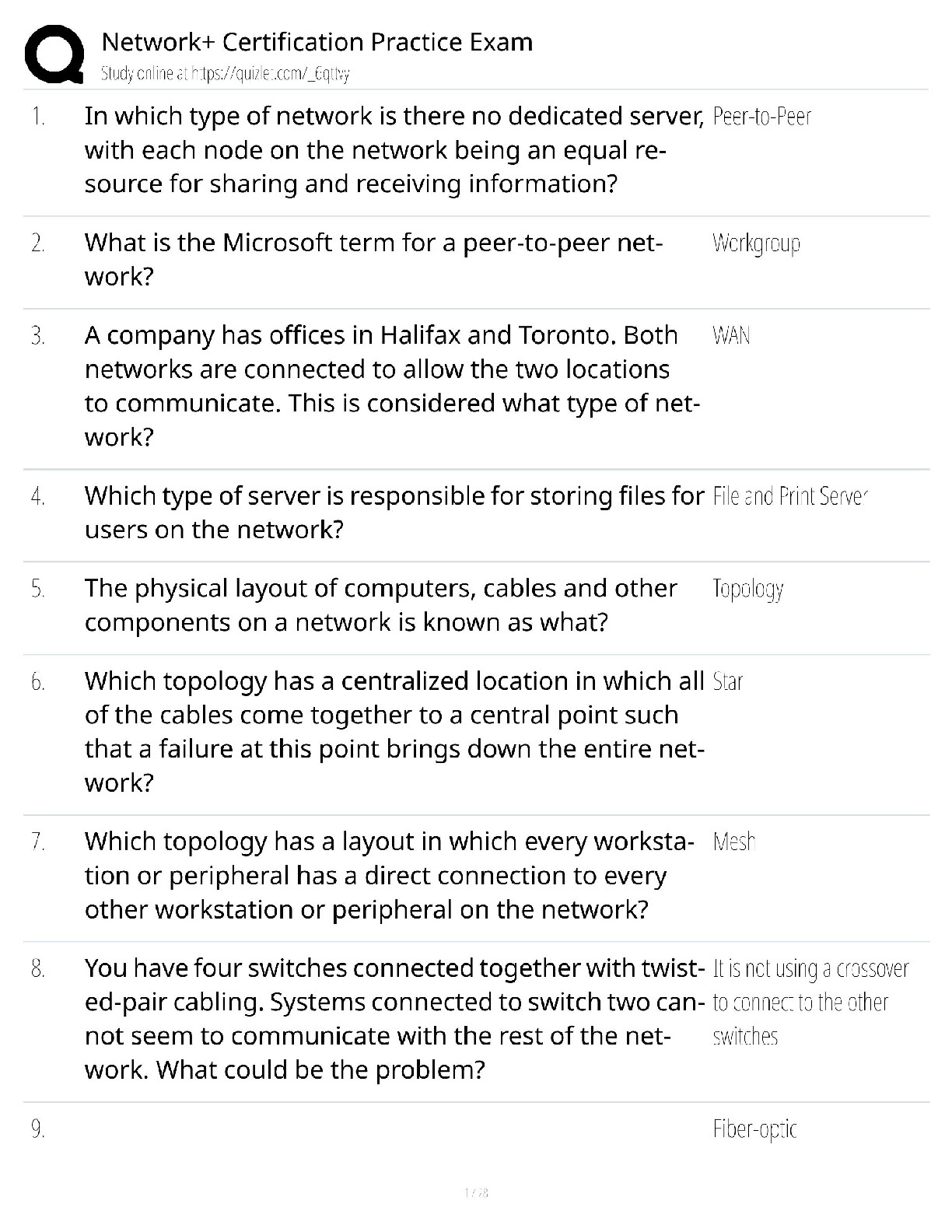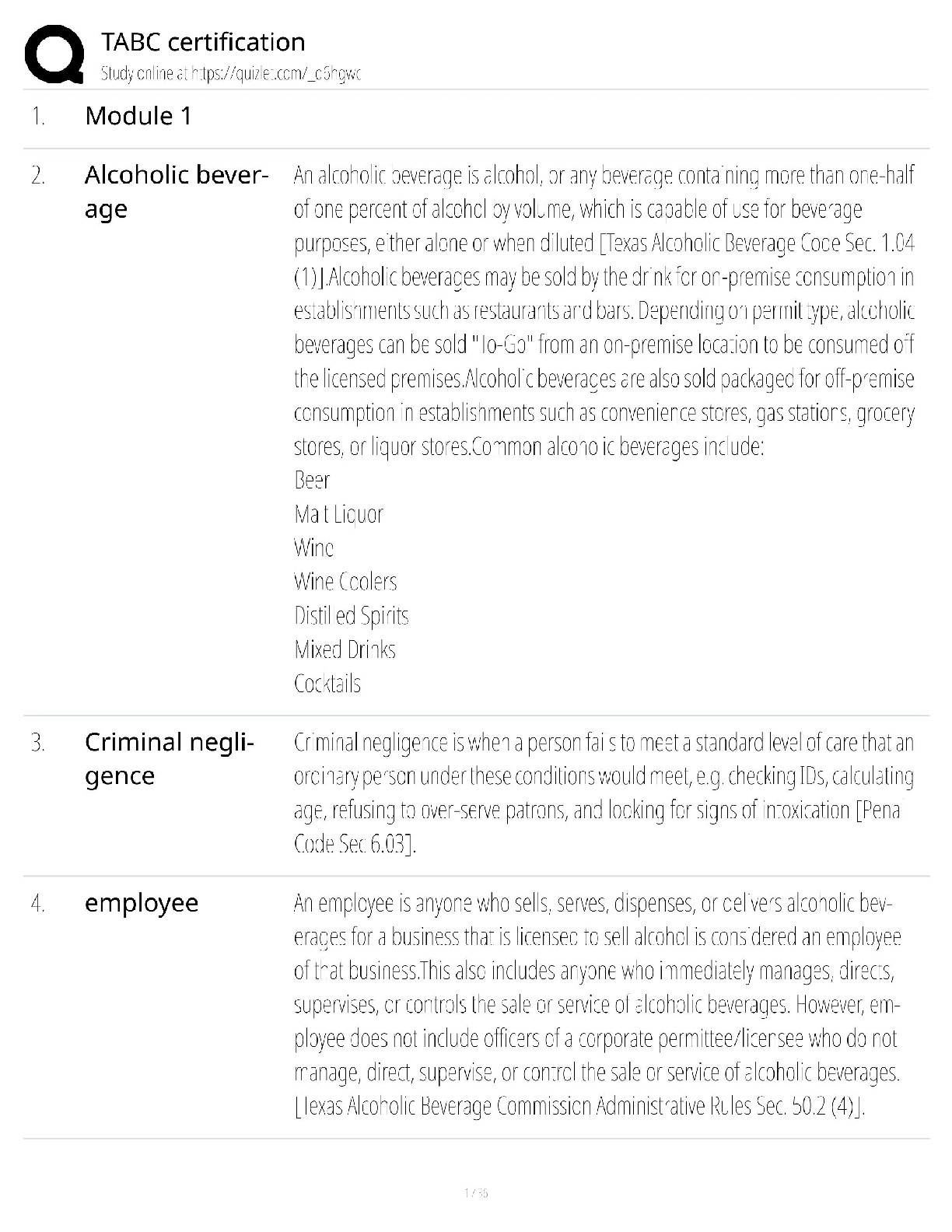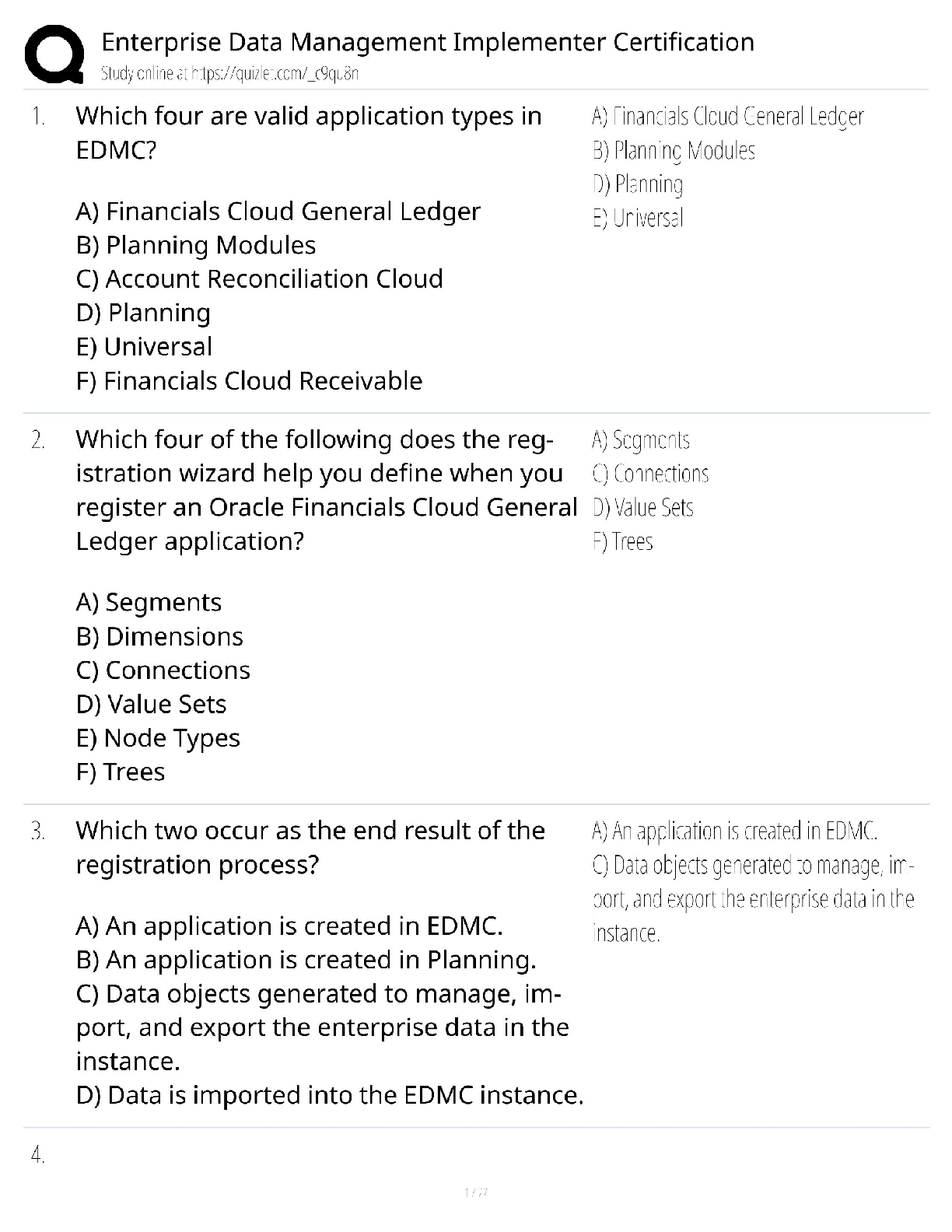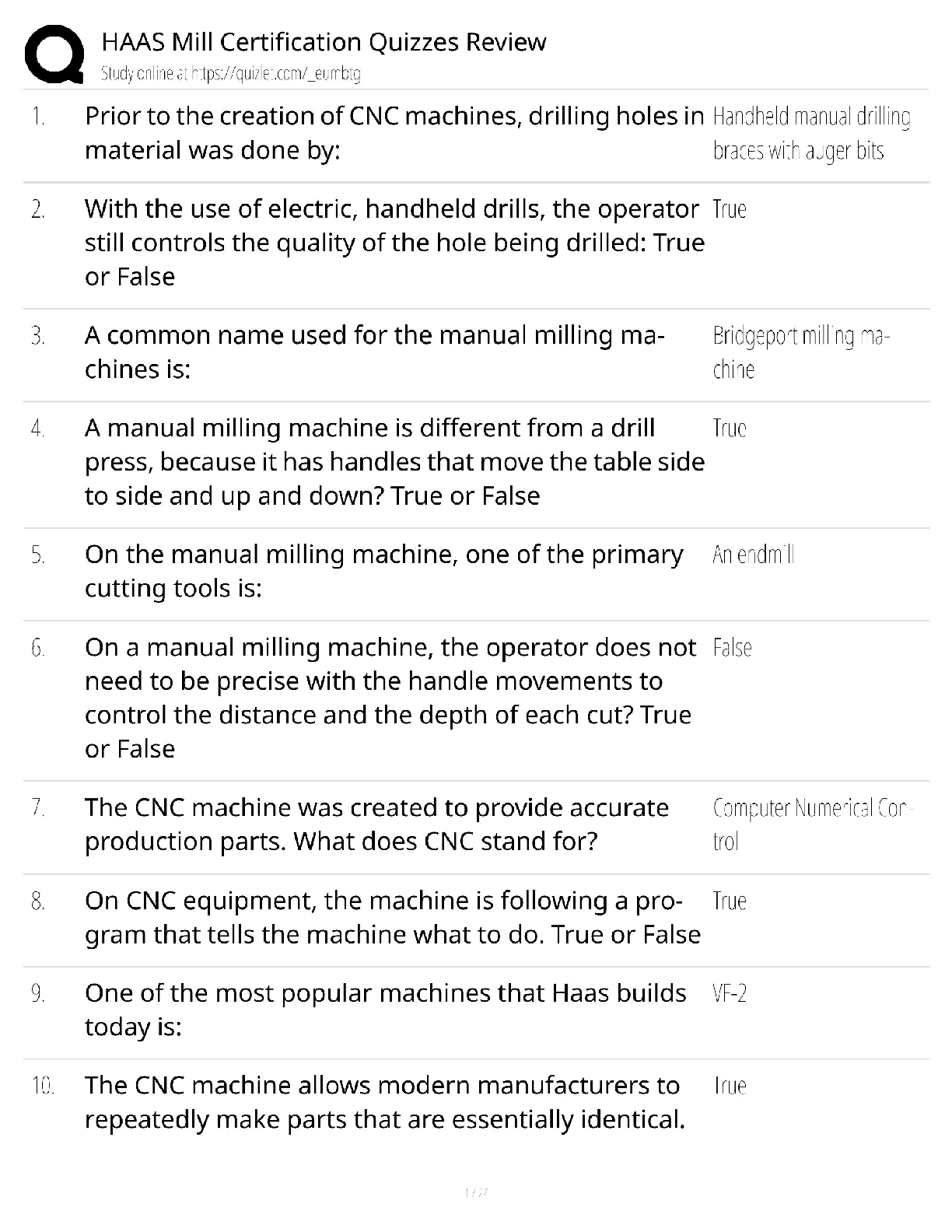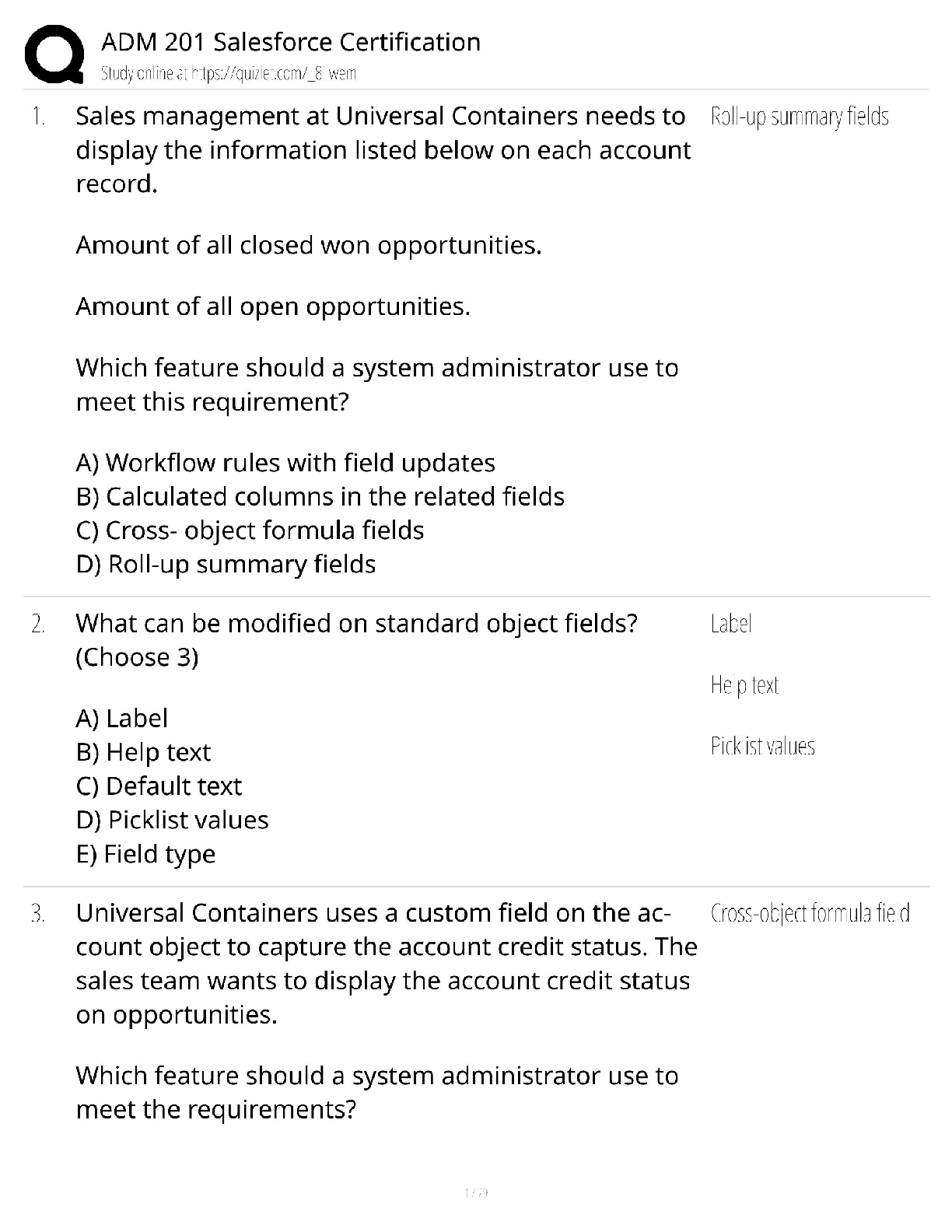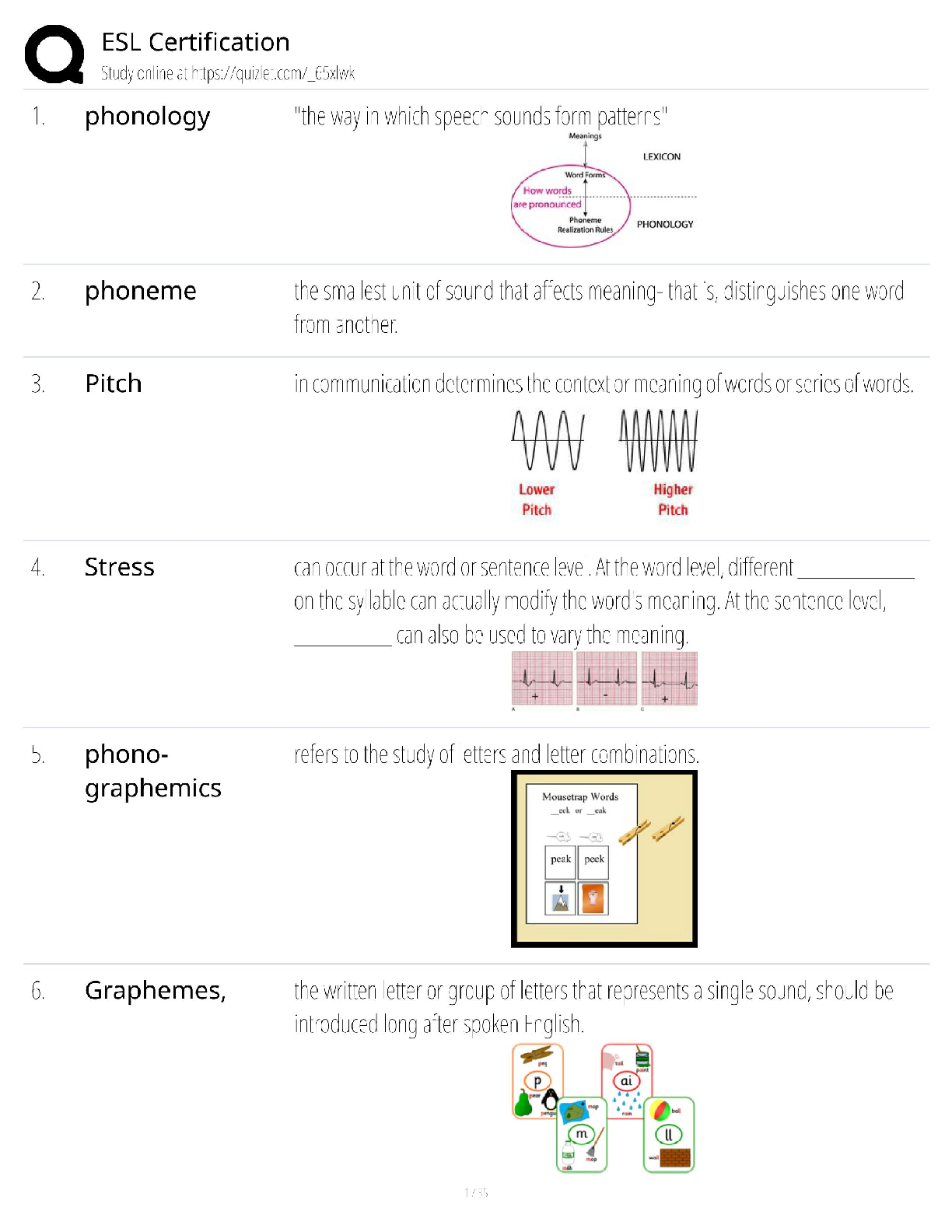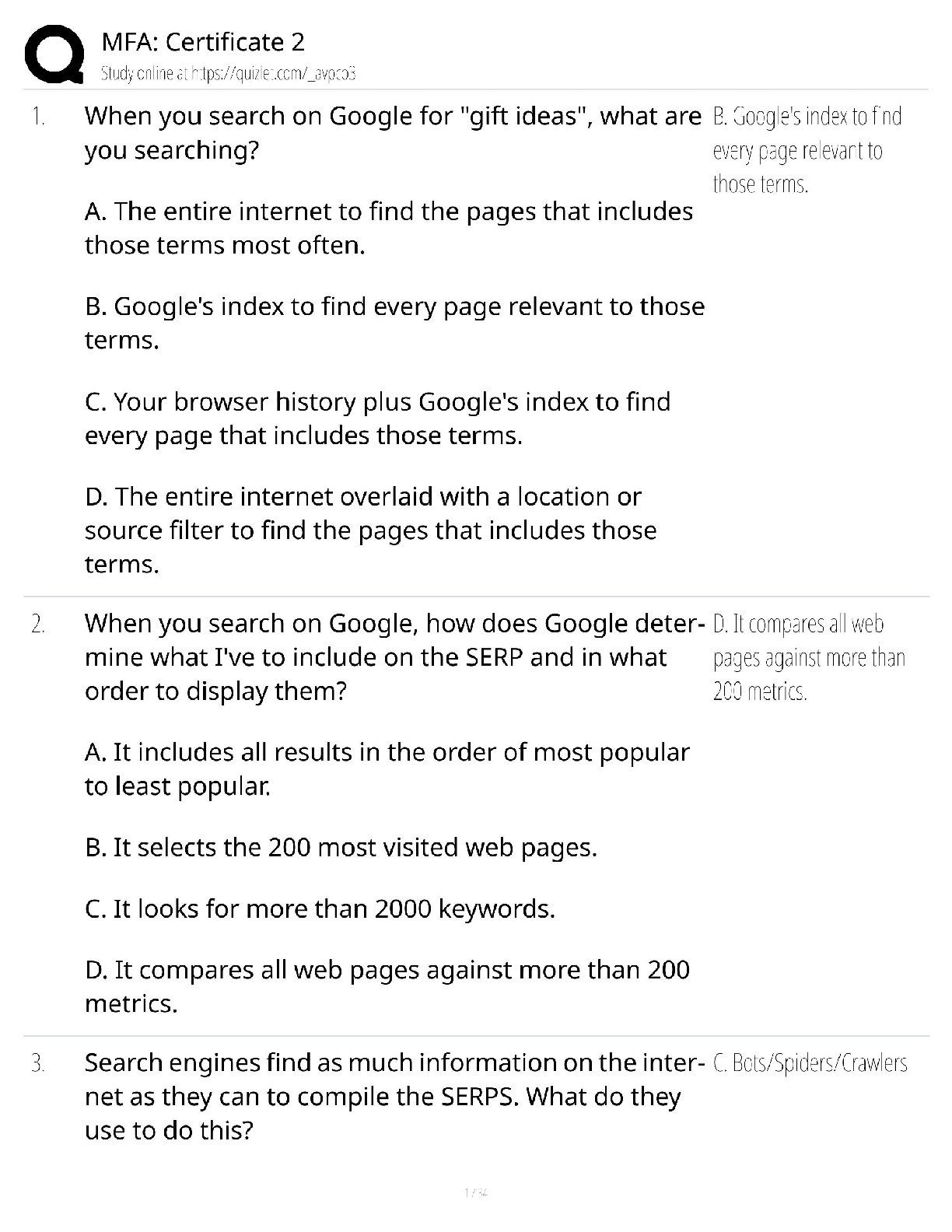*NURSING > QUESTIONS & ANSWERS > NR 511 midterm questions with accurate answers, Graded A. Latest update. (All)
NR 511 midterm questions with accurate answers, Graded A. Latest update.
Document Content and Description Below
NR 511 midterm questions with accurate answers, Graded A. Latest update. Question 2: Which drug for Alzheimer's disease should be administered beginning at the time of diagnosis? a. Cholinester ... ase inhibitors b. Anxiolytics c. Antidepressants d. Atypical antipsychotics - ✔?a. cholinesterase inhibitors pg Question 3: Most adult poisonings are: a. intentional and self-inflicted. b. accidental. c. caused by someone wishing to do harm to the person. d. not attributed to any reason. - ✔?b. accidental. Question 4: A 58-year-old woman presents with a breast mass. Which of the following responses by the clinician would be most appropriate? a. "It is probably just a cyst, because that is the most common breast mass." b. "We will order a mammogram and ultrasound to help establish a diagnosis." c. "We will go ahead and schedule you for a biopsy because that is the only way to know for sure." d. "Because your lump is painful, it is most likely not cancer." - ✔?"We will order a mammogram and ultrasound to help establish a diagnosis." Question 5: Which of the following is a specific test for multiple sclerosis (MS)? a. Magnetic resonance imaging (MRI) b. Computed tomography (CT) scan c. A lumbar puncture d. There is no specific test. - ✔?d. There is no specific test. Question 7: Which characteristic of delirium helps to distinguish delirium from dementia? a. Abrupt onset b. Impaired attention c. Affective changes d. Delusions - ✔?Abrupt onset Question 8: Which clinical feature is the first to be affected in increased intracranial pressure (ICP)? a. Decrease in level of consciousness (LOC) b. Headache c. Nausea d. Widening pulse pressure - ✔?Decrease in level of consciousness (LOC) Question 9: Jennifer is an 18-year-old girl who comes to the emergency room after a fall during a soccer game. Jennifer explains that she fell on her left side and kept her arm out straight to break her fall. She has been experiencing severe pain and limited range of motion in her left shoulder. The clinician has diagnosed Jennifer with a dislocated shoulder. Which of the following statements are true concerning shoulder dislocation? a. Posterior dislocations are more common than anterior dislocations. b. There is a risk of neurovascular and neurosensory trauma, so the clinician should check for distal pulses. c. Recurrent dislocations are uncommon and would require a greater force to result in injury. d. Surgery is most commonly the treatment of choice. - ✔?There is a risk of neurovascular and neurosensory trauma, so the clinician should check for distal pulses. Question 10: Which of the following signs or symptoms indicate an inflammatory etiology to musculoskeletal pain? a. Decreased C-reactive protein b. Hyperalbuminemia c. Morning stiffness d. Weight gain - ✔?morning stiffness Question 11: The clinician sees a patient who is 5 feet tall and weighs 150 pounds. How would the clinician classify this patient? a. Overweight b. Mild obesity c. Moderate obesity d. Morbid obesity - ✔?Mild obesity Question 13: A 23-year-old sexually active woman presents for her first Pap smear. Her history includes nulligravida, age at first intercourse 14, and more than 10 sexual partners. Which of the following conditions should the clinician be particularly alert for during her exam? a. Human papillomavirus (HPV) b. Endometrial hyperplasia c. Vagismus d. Polycystic ovarian syndrome - ✔?Human papillomavirus (HPV) Question 14: Which of the following classes of drugs should be used as first-line therapy for treatment of delirium? a. Benzodiazepines b. Antipsychotics c. Anticonvulsants d. Antidepressants - ✔?Antipsychotic Question 15: What is the treatment of choice for a patient diagnosed with testicular cancer? a. Radical orchidectomy b. Lumpectomy c. Radiation implants d. All of the above - ✔?treatment of choice for a patient diagnosed with testicular cancer? Radical orchidectomy Question 16: A 24-year-old woman presents to the clinic with dysuria, dyspareunia, and a mucopurulent vaginal discharge. Her boyfriend was recently treated for nongonococcal urethritis. What sexually transmitted disease (STD) has she most probably been exposed to? a. Gonorrhea b. Human papillomavirus (HPV) c. Chlamydia d. Trichomonas - ✔?Chlamydia Question 17: A 58-year-old woman who had a total abdominal hysterectomy at the age of 45 is diagnosed with atrophic vaginitis. Which of the following is the most appropriate treatment? a. Conjugated estrogen 0.625 mg/day oral b. Estradiol 7.5 mcg/24 hr vaginal ring c. Medroxyprogesterone 10 mg/day oral d. Conjugated estrogen 0.3 mg + medroxyprogesterone 1.5 mg/day oral - ✔?Estradiol 7.5 mcg/24 hr vaginal ring Question 18: When looking under the microscope to diagnose an intravaginal infection, you see a cluster of small and oval to round shapes. What do you suspect they are? a. Spores b. Leukocytes c. Pseudohyphae d. Epithelial cells - ✔?spores Patients with a spontaneous pneumothorax should be counseled that up to what percentage may experience a reoccurrence at some point? a. 10% b. 20% c. 30% d. 50% - ✔?30% Question 20: John is a 16-year-old boy who presents to the emergency room after hurting his knee in a football game. He described twisting his knee and then being unable to extend it completely. John tells the clinician that he heard a pop when the injury occurred and has been experiencing localized pain. The clinician suspects a meniscal tear. Which test would be most appropriate to assess for the presence of a meniscal tear? a. Valgus stress test b. McMurray circumduction test c. Lachman test d. Varus stress test - ✔?McMurray circumduction test Question 21: During a digital rectal exam (DRE) on a 75-year-old man, the clinician suspects the patient has prostate cancer. What physical finding should make the clinician suspicious? a. An enlarged rubbery gland b. A hard irregular gland c. A tender gland d. A boggy gland - ✔?An enlarged rubbery gland Question 22: Janet is a 30-year-old woman who has been recently diagnosed with a herniated disc at the level of L5-S1. She is currently in the emergency room with suspicion of cauda equina compression. Which of the following is a sign or symptom of cauda equina compression? a. Gastrocnemius weakness b. A reduced or absent ankle reflex c. Numbness in the lateral foot d. Paresthesia of the perineum and buttocks - ✔?Paresthesia of the perineum and buttocks Question 24: A patient is diagnosed with hypothyroidism. Which of the following electrocardiogram (ECG) changes should the clinician expect as a manifestation of the disease? a. Sinus bradycardia b. Atrial fibrillation c. Supraventricular tachycardia d. U waves - ✔?Sinus bradycardia Question 25: Which type of burn injury results in destruction of epidermis with most of the dermis, yet the epidermal cells lining hair follicles and sweat glands remain intact? a. Superficial burns b. Superficial partial-thickness burns c. Deep partial-thickness burns d. Full-thickness burns - ✔?Deep partial-thickness burns Question 26: Immunizations are an example of which type of prevention? a. Primary b. Secondary c. Tertiary - ✔?a. Primary Question 27: If a previously frostbitten area becomes frostbitten again after it has healed, what might occur? a. Permanent tissue damage may occur, resulting in necrosis to that body part. b. The area will be super sensitive. c. The area is prone to a repeat frostbite. d. The area is as susceptible as any other area. - ✔?Permanent tissue damage may occur, resulting in necrosis to that body part. Question 29: Julie, aged 50, has migraine headaches, frequent asthma attacks, coronary artery disease, and hypertension. Which of the following prophylactic medications would you order for her migraines? a. Propranolol c. Ergotamine b. Timolol d. Topiramate - ✔?d. Topiramate Which of the following statements is true concerning the musculoskeletal pain? - ✔?The uninvolved side should be examined initially and compared to the involved side. Question 1: In an outpatient setting, what is the most common reason for a malpractice suit? a. Failure to treat a condition b. Failure to diagnose correctly c. Ordering the wrong medication d. Failure to manage care - ✔?Failure to diagnose correctly Question 2: How often should the clinician examine the feet of a person with diabetes? a. Once a year b. Every 6 months c. Every 3 months d. Every visit - ✔?d. Every visit Question 4: Which of the following medications is the treatment of choice for trichomonas? a. Metranidazole b. Ceftriaxone c. Diflucan d. Doxycycline - ✔?a. Metranidazole Question 16: S presents in the clinic with pain, tenderness, erythema, and swelling of his left great toe. The clinician suspects acute gout. Which of the following should the clinician suspect in the initial test results for this patient? a. Elevated uric acid level b. Elevated blood urea nitrogen (BUN) c. Decreased urine pH d. Decreased C-reactive protein (CRP) - ✔?Elevated uric acid level Question 17: Which of the following statements is true regarding the treatment of carpal tunnel syndrome? a. The goal of treatment is to prevent flexion and extension movements of the wrist. b. Splints are used in carpal tunnel syndrome because they allow for free movement of the fingers and thumb while maintaining the wrist in a neutral position. c. Corticosteroid injections are discouraged in the treatment of carpal tunnel syndrome because of the risks for median nerve damage, scarring, and infection. d. All of the above - ✔?d. All of the above The goal of treatment is to prevent flexion and extension movements of the wrist. B) Splints are used in carpal tunnel syndrome because they allow for free movement of the fingers and thumb while maintaining the wrist in a neutral position. C) Corticosteroid injections are discouraged in the treatment of carpal tunnel syndrome because of the risks for median nerve damage, scarring, and infection. Question 21: A sunscreen with a sun-protection factor (SPF) of at least what number will block most harmful ultraviolet (UV) radiation? a. 4 b. 8 d c. 10 d. 15 - ✔?15 Question 24: Sam, aged 65, is started on L-dopa for his Parkinson's disease (PD). He asks why this is necessary. You tell him: a. "L-dopa is neuroprotective." b. "The primary goal of therapy is to replace depleted stores of dopamine." c. "This is the only drug that can provide symptomatic benefit." d. "This is the initial monotherapy drug." - ✔?"The primary goal of therapy is to replace depleted stores of dopamine." Question 25: A 60-year-old man presents with an enlarged scrotum. The clinician uses a penlight to transilluminate the scrotum. In a patient with a hydrocele, what would the clinician expect to find? a. The scrotum will be dark. b. The scrotum will appear light pink or yellow. c. The scrotum will appear milky white. d. The internal structures will be clearly visible. - ✔?The scrotum will appear light pink or yellow. Question 29: A 22-year-old male is seen in the clinic because he found a hard lump in his testicle when performing testicular self-examination (TSE). Which of the following should be included in the list of differential diagnoses? a. Testicular cancer b. Inguinal hernia c. Varicocele d. All of the above - ✔?Answer D Testicular cancer Inguinal hernia Varicocele Question 35: Which of the following laboratory findings should the clinician expect in a patient with untreated Graves' disease? a. Elevated thyroid-stimulating hormone (TSH) b. Elevated T4 c. Elevated TRH d. All of the above - ✔?Answer D Elevated thyroid-stimulating hormone (TSH) b. Elevated T4 c. Elevated TRH Question 39: The criteria for diagnosing generalized anxiety disorder in the American Psychiatric Association's Diagnostic and Statistical Manual of Mental Disorders (text revision) (DSM-IV-TR) state that excessive worry or apprehension must be present more days than not for at least: a. 1 month. b. 3 months. c. 6 months. d. 12 months. - ✔?6 months Question 40: The clinician has instructed Sam, a 25-year-old patient with low back strain, to use NSAIDs to manage his symptoms of pain and discomfort. Which of the following statements would be most appropriate when teaching Sam about the use of NSAIDs to manage his pain? a. You should start with the lowest dose that is effective in managing your pain, because long-term use of NSAIDs can result in gastrointestinal (GI) disorders such as ulcers and hemorrhage. b. You should start with the lowest dose that is effective in managing your pain in order to avoid developing tolerance to the medication. c. You should take the maximum recommended dose of NSAIDs so that you will not need to take narcotics to control your pain. d. It is important to take NSAIDs on an empty stomach in order to increase absorption. - ✔?You should start with the lowest dose that is effective in managing your pain, because long-term use of NSAIDs can result in gastrointestinal (GI) disorders such as ulcers and hemorrhage. Question 46: In the United States, what is the second most common connective tissue disease and the most destructive to the joints? a. Osteoarthritis b. Systemic lupus erythematosus (SLE) c. Rheumatoid arthritis (RA) d. Sjogren's syndrome - ✔? Question 42: Sam is a 25-year-old man who has been diagnosed with low back strain based on his history of localized low back pain and muscle spasm along with a normal neurological examination. As the clinician, you explain to Sam that low back pain is a diagnosis of exclusion. Which of the following symptoms would alert the clinician to the more serious finding of a herniated nucleus pulposus or ruptured disc? a. Morning stiffness and limited mobility of the lumbar spine b. Unilateral radicular pain symptoms that extend below the knee and are equal to or greater than the back pain c. Fever, chills, and elevated erythrocyte sedimentation rate d. Pathologic fractures, severe night pain, weight loss, and fatigue - ✔?Unilateral radicular pain symptoms that extend below the knee and are equal to or greater than the back pain Question 48: A 45-year-old woman is seen in the clinic with complaints of a vaginal discharge. The clinician identifies clue cells on the vaginal smear. Which of the following diagnoses is associated with this finding? a. Trichomonas b. Bacterial vaginosis c. Human papillomavirus (HPV) d. Herpes simplex virus (HSV) - ✔?Bacterial vaginosis A 64-year-old man with type 2 diabetes presents to the clinic with the complaint of "my feet feel like they are on fire." He has a loss of vibratory sense, +1 Achilles reflex, and a tack embedded in his left heel. Which of the following would be an appropriate treatment? a. Tricyclic antidepressants b. Capsacin cream c. Vitamin B12 injections d. Insulin - ✔?a. Tricyclic antidepressants Which of the following is a crucial element of developing a guideline? a. Creating a physician expert panel b. Reviewing the literature with ratings of available evidence c. Conducting an external review of a guideline d. Developing evidence-based tables - ✔?B. Reviewing the literature with ratings of available evidence Question 2: African American patients seem to have a negative reaction to which of the following asthma medications? a. Inhaled corticosteroids b. Long-term beta-agonist bronchodilators c. Leukotriene receptor agonist d. Oral corticosteroid - ✔?b. Long-term beta-agonist bronchodilators Jolene has breast cancer that has been staged as T1, N0, M0. What might this mean? a. The tumor size cannot be evaluated, the cancer has not spread to the lymph nodes, and the distant spread cannot be evaluated. b. The cancer is in situ, it is spreading into the lymph nodes, but the spread otherwise cannot be evaluated. c. The cancer is less than 2 cm in size and has not spread to the lymph nodes or other parts of the body. d. The cancer is about 5 cm in size, nearby lymph nodes cannot be evaluated, and there is no evidence of distant spreading - ✔?c. The cancer is less than 2 cm in size and has not spread to the lymph nodes or other parts of the body Sondra's peripheral vestibular disease causes dizziness and vertigo. Which of the following medications will help to decrease edema in the labyrinth of the ear? a. Meclizine b. Diphenhydramine c. Diamox d. Promethazine - ✔?c. Diamox Mandy presents with a cauliflower-like wart that is in her anogenital region. You suspect it was sexually transmitted and document this as a: a. Filiform/digitate wart. b. Dysplastic cervical lesion. c. Condyloma accuminata. d. Koilocytosis. - ✔?Condyloma accuminata Inattention and a sleep-wake cycle disturbance are the hallmark symptoms of? a. Dementia [Show More]
Last updated: 3 years ago
Preview 1 out of 46 pages

Buy this document to get the full access instantly
Instant Download Access after purchase
Buy NowInstant download
We Accept:

Also available in bundle (1)
Click Below to Access Bundle(s)

NR 511 bundle, chambberlain university. 2022/2023 predictor exam. 100% verified.
pass the NR 511 EXAMS WITH EASE. 2022/2023 PREDICTOR PAPERS. 100% VERIFIED. NR 511 bundle, chambberlain university. 2022/2023 predictor exam. 100% verified.
By Topmark 3 years ago
$22
6
Reviews( 0 )
$12.00
Can't find what you want? Try our AI powered Search
Document information
Connected school, study & course
About the document
Uploaded On
Sep 24, 2022
Number of pages
46
Written in
All
Additional information
This document has been written for:
Uploaded
Sep 24, 2022
Downloads
0
Views
214

